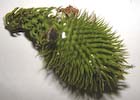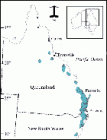
A tree in the Holy Sepulchre Cemetery in Hayward, California [Dan Rivera, 2003.04.04].

Trees of var. glauca in habitat on Magnetic Island [Donald Simpson 2005.01.15].

Foliage on a tree at Huntington Botanical Gardens, California [C.J. Earle, 2001.03].

Foliage from tree of var. glauca on Magnetic Island [Donald Simpson 2009.10.06].

Bark on a tree about 70 cm diameter at Huntington Botanical Gardens [C.J. Earle, 2001.03].

Pollen cones fallen from a tree at Huntington Botanical Gardens [C.J. Earle, 2001.03].

Cone cut by cockatoos from a tree of var. glauca on Magnetic Island [Donald Simpson 2008.12.05].

Distribution of the type variety (Kershaw and Wagstaff 2001). You can also create a highly detailed map, and access specimen data, using the "search" function at the Australia Virtual Herbarium.

Tree at Monte Cecilia Park, Auckland, New Zealand [C.J. Earle, 2003.03.12].

Foliage on the above tree. Note stiff, coralloid appearance, quite unlike typical variety [C.J. Earle, 2003.03.12].

Cones on the above tree, also unlike typical variety [C.J. Earle, 2003.03.12].

Conservation Status

Araucaria cunninghamii
Mudie 1829
Common names
Hoop pine, Moreton Bay pine, colonial pine, arakaria, Dorrigo Pine (Newbury [no date]) [English]; coonam, coorong, cumbertu [Native languages within its range]; Araucaria di Cunningham [Italian]; араукария Куннинэма [Russian]; 南洋杉 (nan yang shan) [Chinese] (Farjon et al. 2014).
Taxonomic notes
This analysis recognizes two varieties, the type and papuana. There is some evidence to suggest that the plants of Magnetic Island, off the coast of Queensland, constitute a third variety: Araucaria cunninghamii var. glauca (Antoine) Endl. 1847. The photographs shown at right illustrate how the foliage and tree form of the Magnetic Island population differ from those of the type variety. These are the closest I have come to seeing the Magnetic Island trees and they certainly look much different from the type variety with regard to growth form.
Synonymy (for the type variety):
- Eutacta cunninghamii (Aiton ex A. Cunn.) Sweet 1841
- Eutassa cunninghamii (Aiton ex A. Cunn.) Spach 1841
- Araucaria cunninghamii var. longifoliaAntoine 1846
- Araucaria cunninghamii var. glauca (Antoine) Endl. 1847
- Araucaria glauca Antoine 1846
- Araucaria cunninghamii subsp. tahitiensis Silba 2013
Description
Monoecious evergreen trees to 60 m tall and 130 cm dbh with an asymmetrical crown. Bark rough, in horizontal bands, exfoliating in fine circular bands. Branches long, twigs in tufts at the ends. Seasonal twigs to 2 cm diameter. Juvenile leaves spirally arranged, green or glaucous, margins entire, flattened, stomata on both surfaces. Adult leaves scale-like, 0.8-2 cm long, incurved, acute, imbricate, keeled on both sides, stomata on both surfaces. Pollen cone cylindrical, 20-30 × 5-7 mm, with short involucral leaves, with 10 scales; microsporophylls rhombic, obtuse. Seed cone ovoid, symetrical, 8-10 × 6-8 cm, scales with reflexed spines. Seeds 15 × 6-7 mm with narrow wings. Cotyledons 2, germination epigeal (Silba 1986). See García Esteban et al. (2004) for a detailed characterization of the wood anatomy, which differs between the type and var. papuana.
Bark heavily impregnated with resin, thus much more resistant to decay than the wood (Newbury [no date]).
Distribution and Ecology
Australia: Coastal tropical and subtropical rainforests from northern Queensland to Coffs Harbour in New South Wales, at 0-1000 m elevation (Silba 1986, Newbury [no date]). Variety papuana occurs in the Arfak Mountains of western New Guinea.
Zone 10 (cold hardiness limit between -1°C and +4.4°C) (Bannister and Neuner 2001).
Remarkable Specimens
Australia's National Register of Big Trees (2020) currently assigns championship to a tree 193 cm dbh and 37 m tall (2017 measurement), located in Bowraville, New South Wales. This also has the largest known girth. Although no longer in a forest, it is a remnant, presumably from natural regeneration. The tallest specimen is also in a forest remnant; 44 m tall (2009), it grows in the Bunya Mountains.
Ethnobotany
Widely planted in Australia, both ornamentally and in timber plantations. The timber is "a first-class softwood varying from almost white to cream or light brown. A plain timber of even texture without prominent grain or growth rings. Peels easily; the Australian plywood industry was founded largely on hoop pine. Virtually odourless. Durable in the dry but may be susceptible to fungi. Easy to work. Readily accepts a wide variety of stains and finishes. Uses: Plywood, cabinet work, furniture, flooring, mouldings and linings, boat building. At one time used for butter boxes, fruit boxes. Widely available" (Newbury [no date]).
In historic times it was an important source of timber for masts and spars of sailing ships. Here is a relevant historical account: "The Spitfire having sprung her topmast, some of the party landed at Magnetical Island for the purpose of cutting a pine spar on the morning of the 17th September... The formation of this island also is granitic, immense boulders of this rock lining the shores and being piled on the summits and strewed over the slopes of the hills in wild confusion. Lofty pines spring out of the crevices of the rocks, giving considerable beauty to the scenery. The timber of this pine is rather heavy, but tough, and with a beautiful grain, qualities which recommend it for house and boat building, furniture, &c. It appears most nearly allied to the Araucaria Cookei" (the Moreton Bay Courier, December 15, 1860).
The species is likely not suitable for dendrochronology, as "trees growing in a seasonal tropical climate in north Queensland produce latewood during cooler and drier periods. Vascular cambium growth rates fluctuate, and slow-growing trees temporarily have inactive cambium around parts of the trunk so no growth ring is formed" (Ash 1983).
Observations
Have see widely in Queensland; the largest specimens (and, in the least-disturbed forest) were in Lamington Mountains National Park on the Queensland-New South Wales border. The trees are common in the area and Park personnel can direct you to the location of notable specimens.
Remarks
This species is named for the celebrated early 19th Century Australia and New Zealand botanist Allan Cunningham (1791-1839).
I have a report from Magnetic Island that the cones of those trees are consumed by sulphur-crested white cockatoos Cacatua galerita (D. Simpson email 2009.10.09). This behavior is not surprising; see the A. angustifolia page for accounts of similar behavior by a corvid called the blue gralha, and many other conifers also constitute a food source for local birds. However, I have seen bird-conifer symbioses of this type only described for these two species of Araucaria.
For pollination mechanisms, see Araucaria.
Citations
Ash, J. 1983. Growth rings in Agathis robusta and Araucaria cunninghamii from tropical Australia. Australian Journal of Botany 31: 269-275.
Farjon, A., M. Gardner M. and P. Thomas. 2014. Conifer Database. In: Roskov et al. (eds.), Species 2000 & ITIS Catalogue of Life. http://www.catalogueoflife.org/col/details/species/id/cf778bd2546f2d9b891a2628149ec91b/source/tree, accessed 2017.05.09, now defunct.
Kershaw, Peter and Barbara Wagstaff. 2001. The southern conifer family Araucariaceae: history, status, and value for paleoenvironmental reconstruction. Annual Review of Ecology and Systematics 32: 397-414.
Mudie, Robert. 1829. The Picture of Australia, p. 133. Available: Internet Archive, accessed 2023.03.04.
National Register of Big Trees. 2012. Tree Register: National Registry of Big Trees. www.nationalregisterofbigtrees.com.au, accessed 2012.06.23.
Newbury, Keith. [no date]. WoodLink VWA Homepage-Hoop Pine. http://home.vicnet.net.au/~woodlink/woodlink.htm (accessed 2003.04.29, now defunct).
See also
Hall et al. (1970).











